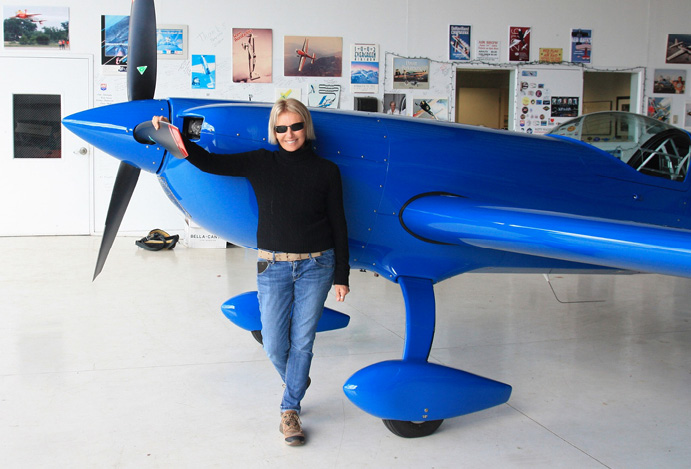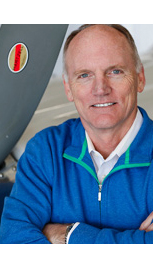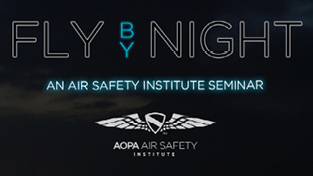Sixty-plus years of aviation safety
AOPA Air Safety Institute continues passionate advocacy for GA
The AOPA Air Safety Institute is committed to reducing general aviation mishaps by providing free educational resources and supporting initiatives that improve general aviation safety and grow the pilot population.
Since 1950, the general aviation accident rate has decreased by 90 percent. It’s no coincidence that’s the same year AOPA created the then-named AOPA Air Safety Foundation, and within 10 years there would be thousands of pilots who took advantage of the “180-degree” rating that provided basic instrument instruction for noninstrument-rated pilots.
In keeping with its mission, in 2008 the AOPA Air Safety Foundation expanded its outreach by creating interactive online courses targeting many safety issues in ways as informative as they are entertaining. The Air Safety Foundation also introduced new ways of learning from the mistakes of others, letting pilots listen to the voices of their peers in “Real Pilot Stories,” and posting blogs to open dialog on issues critical to pilot safety. In 2010, the AOPA Air Safety Foundation took a new name—the AOPA Air Safety Institute—and became part of the AOPA Foundation. The move preserved the expertise and clear focus of this leading safety organization while supporting the broader mission of the AOPA Foundation. In 2016, the AOPA Air Safety Institute allied with the AOPA You Can Fly Program, which is dedicated to growing the pilot population. Support is provided by the AOPA Foundation, the association’s fundraising arm. The AOPA Air Safety Institute is the world’s largest and most effective nonprofit organization devoted solely to general aviation safety.
The ASI team’s passion for aviation, creativity, insightful education, research, and analysis is evident in its educational offerings. From award-winning online courses to in-person seminars, flight instructor renewal courses, accident analysis, and much more, the products are created with the goal of helping all pilots fly more safely.
August 20 marks the one hundredth anniversary of the World War I fighter squadron, led by the legendary flying ace Capt. Eddie Rickenbacker, for which the AOPA Foundation’s Hat in the Ring Society is named. The Hat in the Ring Society is comprised of philanthropists who “throw their hats in the ring” with charitable contributions between $1,000 and $5,000 every year. In that same “first to fight” spirit, Hat in the Ring Society members take pride in the AOPA Foundation’s leadership in shaping and strengthening the freedom to fly. These pilots come together under the Hat in the Ring banner because they believe that general aviation is a cause worth fighting for, and a national treasure that those who love aviation must protect. Web: www.aopafoundation.org/donate
Products and Services
Finding the best appraisals
Most owners can use a pricing digest valuation
An aircraft appraisal is a tool that assures all parties to an aircraft transaction some level of comfort. How thorough of an appraisal do you need? There are three levels of appraisals, each one costing a bit more as the depth of analysis increases: a pricing digest version such as the one offered to AOPA members through Vref, a desktop appraisal, and an onsite or physical appraisal.
Pricing digest valuation
Most transactions can take place with only a Vref or Bluebook analysis. The disadvantage for a pricing digest valuation is that the data is by nature somewhat stale—at least three months old. Also, the true value of upgrades such as avionics or supplemental type certificates can be difficult to determine and may not be as accurate as more costly appraisals.
Also, the pricing digest valuation does not accurately incorporate such fluid things as current supply and demand. If an aircraft was produced in limited numbers and demand fluctuates, the value can be much higher or lower than the pricing digests might indicate. In such cases, it is generally better to spend the money for a desktop appraisal.
Desktop appraisal
A desktop appraisal is done by a certified appraiser. What the certified appraiser does differently than a simple pricing digest valuation is to look at what is currently on the market. The appraiser will also evaluate where the market has been trending, as well as average days on the market, and use that to figure out where pricing is headed. The appraiser will evaluate an individual aircraft to see where it is in its maintenance schedule compared to other similar aircraft for sale to give a more accurate assessment of value. This is especially relevant for turboprops and light jets. Does the aircraft have maintenance expenses coming up? Is it enrolled in an engine maintenance program? A certified appraiser will look at the entire market, do a cursory check of the logbooks and specifications on the aircraft, but will not physically look at the aircraft. The cost of a desktop appraisal is typically $500 or $600.
Physical appraisal
A physical appraisal is the most invasive—almost like a prebuy inspection. It is the gold standard of appraisals. The appraiser will get into the airplane, open panels, thoroughly examine all the engine and maintenance logs, and take a careful look at the aircraft. This type of appraisal is recommended for truly unique aircraft with modifications, and on most jet aircraft it is a requirement. The disadvantage of an onsite or physical appraisal is its cost—typically $2,000 to $3,000 or more.
Adam Meredith is president of the AOPA Aviation Finance Co. Call 800-62-PLANE (7-5263) or visit aopafinance.org.
AOPA Insurance
When your luck runs out
AOPA Insurance is there when you need it
In the summer of 1964, John Johnson sold his Harley-Davidson motorcycle to pay for flying lessons in a Cessna 120. He paid $6 an hour wet and $8 an hour with an instructor. “I’ve been fascinated with airplanes since I was a toddler. We lived in Wichita, and dad used to take me out to the airport on Sunday afternoons to watch the airplanes,” Johnson says. “My wife and both our sons are pilots as well, the younger son flying for Delta. It must be hereditary.”
Johnson is a commercial pilot with instrument, multiengine, and flight instructor certificates and ratings. He is qualified to fly a Soko Galeb G2A, a Yugoslav single-engine, two-seat jet trainer. He has about 4,500 hours total time.
Johnson currently owns and flies a Piper Comanche 250 and a Piper Lance. A typical trip takes him to Minneapolis’ Flying Cloud Airport or Houston’s Sugarland, with occasional trips to Destin, Florida; Jackson Hole, Wyoming; St. Louis, Missouri; Tulsa, Oklahoma; and Kansas City and Joplin, Missouri.
Johnson became an AOPA Insurance customer when he bought his first airplane, a Beechcraft Debonair. He never had to make a claim, however, until three years ago when the nose gear of his Lance collapsed during taxiing. “I found AOPA and AIG to be prompt, responsive, and uncomplaining,” he said. “I had to call on them again three months ago when all the avionics and most of the instruments were stolen from the Lance while it overnighted in Texas, and again, their help has been great. I don’t think I could possibly have expected better service on a disheartening problem. Thanks, AOPA and AIG.”
AOPA Insurance offers knowledgeable agents who can understand your flying and insurance requirements. Visit us online.
ASI News
Introducing the There I Was… podcast series
Hop on board with Patty Wagstaff
By Machteld Smith
 At airport hangars across the United States, pilots share flying adventures with others. These hangar-flying cookouts and social gatherings lend an opportunity to tell fun stories, compare experiences, and have a good time. Yet, amid tall tales and entertainment, you also will catch nuggets of aviation wisdom that may come in handy during a flight. With that in mind, the AOPA Air Safety Institute recently launched its There I Was… podcast. The stories honor the hangar-flying tradition of sharing experience and knowledge.
At airport hangars across the United States, pilots share flying adventures with others. These hangar-flying cookouts and social gatherings lend an opportunity to tell fun stories, compare experiences, and have a good time. Yet, amid tall tales and entertainment, you also will catch nuggets of aviation wisdom that may come in handy during a flight. With that in mind, the AOPA Air Safety Institute recently launched its There I Was… podcast. The stories honor the hangar-flying tradition of sharing experience and knowledge.
In episode one, U.S. National Aerobatic Champion Patty Wagstaff recounts a Cessna 185 flight in southwestern Alaska. Wagstaff was aware of the region’s weather patterns, but the sudden encounter with instrument conditions still took her by surprise. Should she maintain visual flight and descend toward terrain or trust her flight instruments and climb into the weather and ice? As an instrument-rated pilot who had not flown in actual weather, she made a quick, critical decision.
The podcast’s conversational tone allows Wagstaff and her hosts to explore the merits of being resourceful. It also offers a valuable discussion on steps pilots can take for the best possible outcome of a flight. Learn how Wagstaff got everyone back on the ground unharmed.
Machteld Smith is an aviation technical writer for the AOPA Air Safety Institute.
The Air Safety Institute is passionate about aviation safety. ASI has produced free programs for more than half a century with the goal of helping all pilots fly more safely. Please consider donating to the AOPA Foundation to support these programs.
Time Lapse accident case study. In-cockpit weather information is a great tool, but it’s important to fully understand the limitations, especially during thunderstorm season. For example, Nexrad radar can be as much as 20 minutes older than the age indication on the cockpit display. Accident Case Study: Time Lapse highlights this problem. The study examines a pilot’s mistake of relying on datalink weather displays to navigate around quickly developing weather systems with fast-moving convective activity.
Member Services
Tips from PIC
Dealing with density altitude
By Patrick Timmerman
With the dog days of summer upon us it is worth reviewing the effects of density altitude. Density altitude is pressure altitude corrected for nonstandard temperature. At sea level, standard temperature is 15 degrees Celsius/59 degrees Fahrenheit. At this temperature, pressure altitude and density altitude would be the same. As temperature and humidity increase, so does density altitude. Regardless of the actual altitude at which you’re flying, the aircraft will perform as if it is at whatever the density altitude is, which might be thousands of feet higher than what the altimeter indicates.
The hotter it is, the more humid it is, and the higher you are, the poorer the aircraft performance. During the takeoff roll, the aircraft will accelerate more slowly and additional runway will be needed, both for takeoff and landing. Once in the air, climb rate will be reduced. Engine performance will decrease as well, often significantly.
It is important to plan ahead when flying on days when the density altitude is high. You might not be able top off the tanks if that is your normal practice. This might require you to fly shorter legs and make more fuel stops. Plan to fly during the cooler times of the day; early morning or in the evening is usually best. Keep the aircraft as light as possible. Doing so can be an inconvenience and an expense, but instead of packing the airplane full of passengers and luggage, consider making more than one trip. Consult your aircraft’s performance charts and carefully calculate the numbers. Be conservative and have a safe flight.
Patrick Timmerman is an aviation technical specialist in the AOPA Pilot Information Center. Questions? Call AOPA at 800-USA-AOPA (872-2672).
NOTICE OF ANNUAL MEETING OF MEMBER
The annual meeting of the members of the Aircraft Owners and Pilots Association will be held at 9 a.m. on Thursday, September 7, 2017, at the headquarters of AOPA, 421 Aviation Way, Frederick, Maryland, 21701, located on the Frederick Municipal Airport (FDK), for the purpose of receiving reports and transacting such other business as may properly come before the meeting, specifically including the election of trustees. If you are not able to attend, but would like to appoint your voting proxy, please go online (www.aopa.org/myaccount) or call 800-872-2672. —Kenneth M. Mead, Secretary
 MEET RICHARD MCSPADDEN, EXECUTIVE DIRECTOR
MEET RICHARD MCSPADDEN, EXECUTIVE DIRECTOR 


